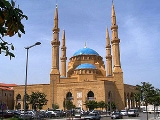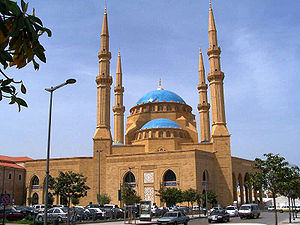
Islam in Lebanon
Encyclopedia

Muslim
A Muslim, also spelled Moslem, is an adherent of Islam, a monotheistic, Abrahamic religion based on the Quran, which Muslims consider the verbatim word of God as revealed to prophet Muhammad. "Muslim" is the Arabic term for "submitter" .Muslims believe that God is one and incomparable...
sects; Shias, Sunnis, Alawite
Alawite
The Alawis, also known as Alawites, Nusayris and Ansaris are a prominent mystical and syncretic religious group centred in Syria who are a branch of Shia Islam.-Etymology:...
s, and Ismailis including the Druze
Druze
The Druze are an esoteric, monotheistic religious community, found primarily in Syria, Lebanon, Israel, and Jordan, which emerged during the 11th century from Ismailism. The Druze have an eclectic set of beliefs that incorporate several elements from Abrahamic religions, Gnosticism, Neoplatonism...
.
Muslims (including Druze) account for 59.7% of the total population of Lebanon, where 39% are Christians. About 25% of the Lebanese
Lebanon
Lebanon , officially the Republic of LebanonRepublic of Lebanon is the most common term used by Lebanese government agencies. The term Lebanese Republic, a literal translation of the official Arabic and French names that is not used in today's world. Arabic is the most common language spoken among...
population is Sunni, concentrated largely in coastal cities. Shi'is - about 35% of the total population of Lebanon - live mostly in the northern area of the Beqaa Valley
Beqaa Valley
The Beqaa Valley is a fertile valley in east Lebanon. For the Romans, the Beqaa Valley was a major agricultural source, and today it remains Lebanon’s most important farming region...
and southern Lebanon. A religious data in 1985 suggests that the number of Muslims has risen, with 75% compared with Christians at 25%. By the 1980s Shi'is became a large confessional group in Lebanon
Lebanon
Lebanon , officially the Republic of LebanonRepublic of Lebanon is the most common term used by Lebanese government agencies. The term Lebanese Republic, a literal translation of the official Arabic and French names that is not used in today's world. Arabic is the most common language spoken among...
, leading to demands for better educational and employment opportunities and redistribution of power based on actual numbers. Druze
Druze
The Druze are an esoteric, monotheistic religious community, found primarily in Syria, Lebanon, Israel, and Jordan, which emerged during the 11th century from Ismailism. The Druze have an eclectic set of beliefs that incorporate several elements from Abrahamic religions, Gnosticism, Neoplatonism...
constitute about 5 percent of the population. Alawis are numerically insignificant but have risen in importance since the Gulf War
Gulf War
The Persian Gulf War , commonly referred to as simply the Gulf War, was a war waged by a U.N.-authorized coalition force from 34 nations led by the United States, against Iraq in response to Iraq's invasion and annexation of Kuwait.The war is also known under other names, such as the First Gulf...
of 1990-1991 due to the growing influence of Syria
Syria
Syria , officially the Syrian Arab Republic , is a country in Western Asia, bordering Lebanon and the Mediterranean Sea to the West, Turkey to the north, Iraq to the east, Jordan to the south, and Israel to the southwest....
, where Alawis dominate the government. Ismailis number only a few hundred and play no significant political role. Religious officials of each sect maintain jurisdiction over personal status law. The distribution of political power is based on religious affiliation: the president must be Maronite Catholic Christian, the speaker of the parliament must be Shiite Muslim and the prime minister must be Sunni Muslim.

